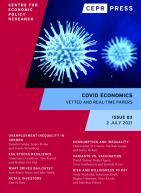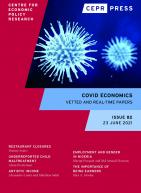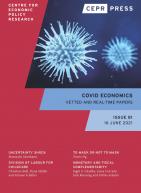
Most integrated models of the covid pandemic have been developed under the assumption that the policy-sensitive reproduction number is certain. The decision to exit from the lockdown has been made in most countries without knowing the reproduction number that would prevail after the deconfinement. In this paper, I explore the role of uncertainty and learning on the optimal dynamic lockdown policy. I limit the analysis to suppression strategies. In the absence of uncertainty, the optimal confinement policy is to impose a constant rate of lockdown until the suppression of the virus in the population. I show that introducing uncertainty about the reproduction number of deconfined people reduces the optimal initial rate of confinement.
Citation
Gollier, C (2020), ‘Pandemic economics: Optimal dynamic confinement under uncertainty and learning‘, COVID Economics 34, CEPR Press, Paris & London. https://cepr.org/publications/covid-economics-issue-34#392514_392910_390540
How does the nature of work – teleworkability and contact intensity – shape the distribution of health, labor income, and unemployment risks, created by the COVID-19 pandemic? To answer this question, we consider two contexts. First, we show that the existing spousal nature-of-work-based occupational sorting in the United States matters for the distribution of these risks. In particular, we show that it mitigates the risk of catching COVID-19 through intra-household contagion relative to the case of zero sorting. Furthermore, we show that it creates a larger fraction of couples, who are excessively exposed to labor income and unemployment risks, relative to the case of zero sorting. Second, we document that teleworkable occupations require higher education and experience levels as well as greater cognitive, social, character, and computer skills relative to non-teleworkable occupations. This discrepancy affects labor income and unemployment risks by increasing the likelihood of skill mismatch for newly unemployed workers. Our results imply that the current economic downturn may have long-run effects on employment prospects and earnings of workers who had non-teleworkable or high-contact-intensity jobs at the onset of the COVID-19 outbreak. We discuss the relevant policy implications and associated policy constraints that follow from our findings.
Citation
Malkov, E (2020), ‘Nature of Work and Distribution of Risk: Evidence from Occupational Sorting, Skills, and Tasks‘, COVID Economics 34, CEPR Press, Paris & London. https://cepr.org/publications/covid-economics-issue-34#392514_392910_390541
While the SARS-CoV2 pandemic has led to a rapid increase in unemployment across the United States, some states have fared better than others at minimizing economic damage and suppressing the disease burden. We examine the political factors behind these outcomes at the individual and institutional levels. First, using new daily data from the Gallup Panel between March and June on roughly 45,000 individuals, we document that heterogeneity in beliefs about the pandemic and social distancing behaviors is driven primarily by political affiliation. In fact, it is systematically more predictive than factors directly connected to the disease, including age, county infections per capita, and state public health policies. Second, we investigate how partisanship led states to adopt laxer or stricter policies during the pandemic. While the more extreme policies have had negative effects on either economic activity or public health, middle-of-the-road policies (e.g., mask-mandates) have been more effective at curbing infections without significant economic damages. However, the effectiveness of these policies—and compliance with them—is mediated by political affiliation. Our results suggest that partisanship can have persistent effects on economic activity and health beyond its effects on sentiment, moving individuals and institutions away from optimal policy.
Citation
Rothwell, J and C Makridis (2020), ‘The Real Cost of Political Polarization: Evidence from the COVID-19 Pandemic‘, COVID Economics 34, CEPR Press, Paris & London. https://cepr.org/publications/covid-economics-issue-34#392514_392910_390542
This paper compares the performance of safe haven assets during two stressful stock market regimes – the 2008 Global Financial Crisis (GFC) and COVID-19 pandemic. Our analysis across the ten largest economies in the world shows that the traditional choice, gold, acts as a safe haven during the GFC but fails to protect investor wealth during COVID. Our results suggest that investors might have lost trust in gold. Furthermore, silver does not serve as a safe haven during either crisis, while US Treasuries and the Swiss Franc generally act as strong safe havens during both crises. The US dollar acts as a safe haven during the GFC for all the countries except for the United States, but only for China and India during COVID. Finally, Bitcoin does not serve as a safe haven for all countries during COVID; however, the largest stablecoin, Tether, serves as a strong safe haven. Thus, our results suggest that, during a pandemic, investors should prefer liquid and stable assets rather than gold.
Citation
Faff, R, K Szulczyk and M Cheema (2020), ‘The 2008 Global Financial Crisis and COVID-19 Pandemic: An Examination of Safe Haven Assets‘, COVID Economics 34, CEPR Press, Paris & London. https://cepr.org/publications/covid-economics-issue-34#392514_392910_390543
Understanding the determinants and implications of delays in reporting COVID-19 deaths is important for managing the epidemic. Contrasting England and Mexico, we document that reporting delays in Mexico are larger on average, exhibit higher geographic heterogeneity, and are more responsive to the total number of occurred deaths in a given location-date. We then estimate simple SIR models for each country to illustrate the implications of not accounting for reporting delays. Our results highlight the fact that low and middle-income countries are likely to face additional challenges during the pandemic due to lower quality of real-time information.
Citation
Rubli, A, T Tavares and E Gutierrez (2020), ‘Delays in Death Reports and their Implications for Tracking the Evolution of COVID-19‘, COVID Economics 34, CEPR Press, Paris & London. https://cepr.org/publications/covid-economics-issue-34#392514_392910_390544
Since the first death in China in early January 2020, the coronavirus (Covid-19) has spread across the globe and dominated the news headlines leading to fundamental changes in the health, social and political landscape, and an unprecedented negative impact on the current and future prospects of households, businesses and the macro-economy. In this paper, we examine consumer spending responses to the onset and spread of Covid-19, and subsequent government imposed lockdown in Great Britain, GB (England, Scotland, Wales). Our sample period spans January 1st 2020 to 7th April 2020. This allows us to observe consumer spending behavior from the initial incubation phase of the crisis. We partition the sample period into incubation (1st-17th January), outbreak (January 18th-February 21st), fever (February 22nd-March 22nd), lockdown (March 23rd–May 10th 2020) and stay alert (May 11th- June 18th) phases. Using a high frequency transaction level proprietary dataset comprising 101,059 consumers and 23 million transactions made available by a financial technology company, we find that discretionary spending declines during the fever period as the government imposed lockdown becomes imminent, and continues to decline throughout the lockdown period. Shortly after the May 10th ‘stay alert’ announcement by Prime Minister Johnson, a short-term decline in spending across all nations occurs. However, a week later, spending is at the same level as that observed prior to the announcement. There is a strong increase in groceries spending consistent with panic buying and stockpiling behaviour in the two weeks following the World Health Organisation (WHO) announcement describing Covid-19 as a pandemic. Variations in the level and composition of consumer spending across nations and regions (particularly during the early stages of the outbreak period), and by age, gender and income level are also observed. Our results are of particular relevance to government agencies tasked with the design, execution and monitoring economic impacts arising from the spread of the virus and the public health measures imposed to mitigate the health costs of the crisis.
Citation
Lukas, M, J Wilson and D Chronopoulos (2020), ‘Consumer Spending Responses to the Covid-19 Pandemic: An Assessment of Great Britain‘, COVID Economics 34, CEPR Press, Paris & London. https://cepr.org/publications/covid-economics-issue-34#392514_392910_390545


Covid Economics - Issue 82
- Restaurant Closures during the Pandemic: A Descriptive Analysis
- Underreporting Child Maltreatment during the Pandemic: Evidence from Colorado
- Covid-19 impact on Artistic Income
- COVID-19, Employment, and Gender: Evidence from Nigeria
- The Importance of Being Earners: Modelling the Implications of Changes to Welfare Contributions on Macroeconomic Recovery
